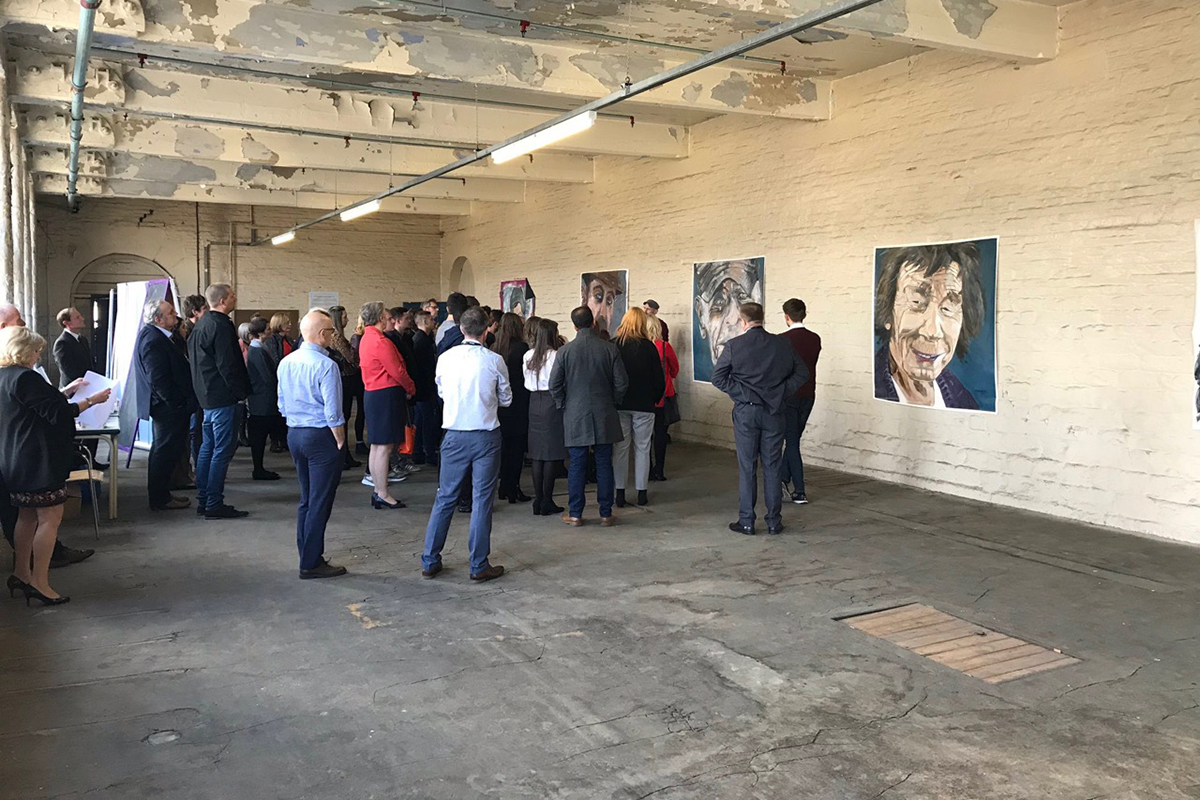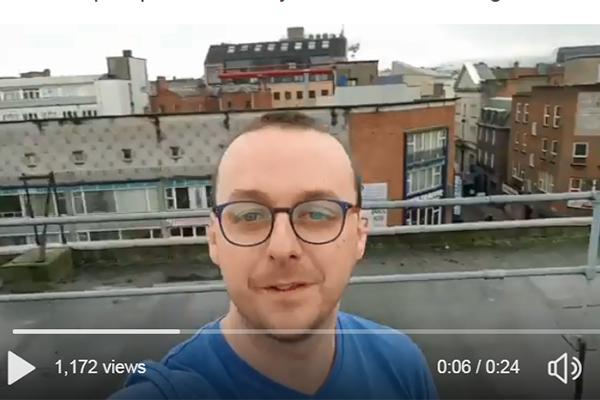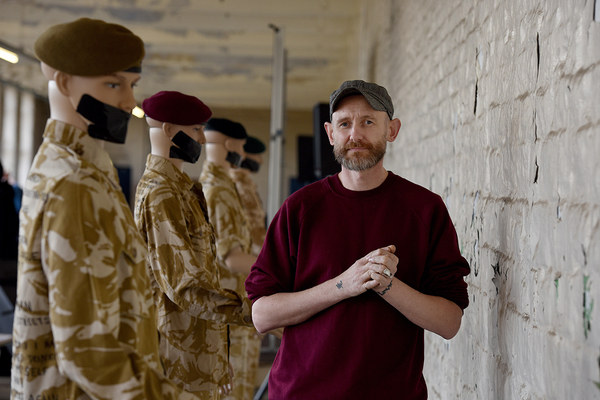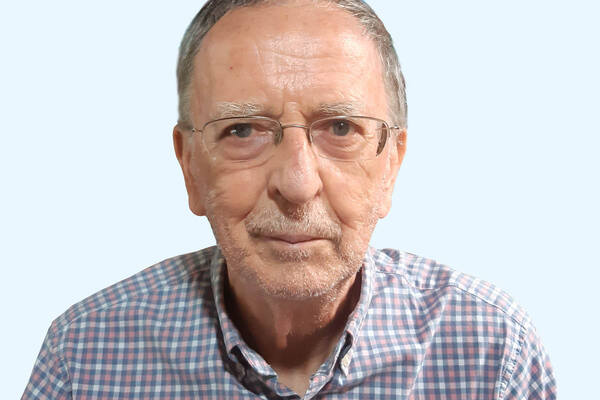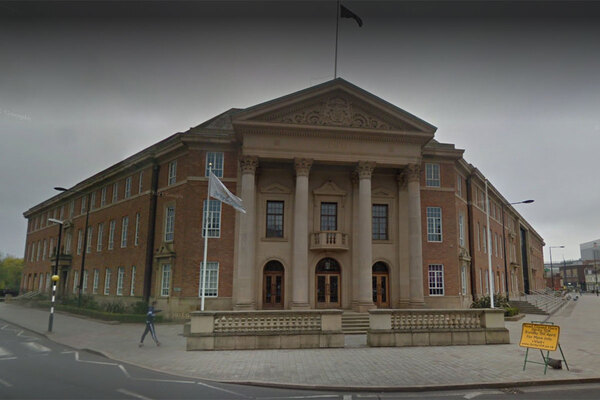You are viewing 1 of your 1 free articles
How young housing professionals rose to an artist’s homelessness challenge
Artist, and former rough sleeper, David Tovey challenged a group of young housing professionals to take a fresh approach to homelessness. Martin Hilditch goes to Saltaire to see how they responded. Photography by Steve Bootle
Above: the GEMs gather at the Salts Mill, Bradford
A year ago, artist David Tovey issued a group of young housing professionals with a call to action.
Over the next 12 months he challenged them to take direct steps to tackle homelessness in their jobs.
Fast forward to October 2018 and it’s the moment of truth. Mr Tovey, who has exhibited at the Tate Modern, Tate Liverpool and Somerset House and who has been homeless himself, is here to find out what, if anything, they have achieved.
The meeting takes place in an area with a few housing stories of its own to tell, the model village of Saltaire, near Bradford – a UNESCO World Heritage site built by Sir Titus Salt to house his workers. Everyone gathers in a huge room in Salts Mill, a grand, grade II-listed former textile mill (also built by Sir Titus) which houses the largest permanent collection of artworks by David Hockney. The day is a combination of history lesson, art lecture, and housing seminar.
Inside Housing is here to find out what the group, who are all part of the Graduate Employment Mentoring (GEM) programme, have achieved – and gain an insight into the work of Mr Tovey for good measure.
The room has been turned into an exhibition – called the Art of Homelessness – of Mr Tovey’s best-known work, including a selection of portraits from his Faces of the Abused series and the installation A Soldier’s Story, detailing the harrowing stories of a number of ex-servicemen, including Mr Tovey, who have become homeless.
In a far corner of the room, a piece from Mr Tovey, commissioned by Shelter, is explicit about the bigger picture at play. “Build more homes”, it screams from the canvas (see picture on previous spread). But against this backdrop, the event is a reminder that individuals sit at the heart of any system – and are at the root of change. Or, as Mr Tovey puts it: “It always starts with a person.”
“The only way you are ever going to help with homelessness is actually by associating with and getting to know the actual person who needs help,” he says, in a speech to the GEMs that is part pep talk and part introduction to his artwork. “They are not a number. They are not a statistic. They are a human being who needs a little bit of a helping hand.”
Before the GEMs present what they’ve been doing, Mr Tovey talks to them about his artwork and experiences to help set the context. Standing in front of a portrait he calls “probably the most important picture in the whole of the exhibition”, he tells the story of a friend who made a big difference in his life, a man called Danny.
“The only way you are ever going to help with homelessness is actually by associating with and getting to know the actual person who needs help" David Tovey
“He was an older guy,” Mr Tovey states. “When I got off the streets and moved into a homeless shelter, Danny lived in the room next to me. He helped me through a stage of my life when I was completely broken. I wasn’t accepting that I had problems. I was still drinking. I was still doing huge amounts of drugs. My mental state was at that breaking point.”
“Danny helped me focus my mind and actually say: ‘You are a human being, you can move on’,” Mr Tovey adds. Danny, however, became depressed after funding cuts ended a gardening project he had worked on for the Chelsea Pensioners. “He drank himself to death,” Mr Tovey reveals.
“It still upsets me that he was there for me but I wasn’t for him because he wouldn’t accept that help. He wouldn’t let anyone through that door.”
The people in the room today, though, can make a difference, Mr Tovey states. “As a sector, you have the power to change people’s lives,” he says. “It happened for me. I was homeless. I was given a social home. I say home, because that is what it is to me. That elevated me, so I could do all this. Every single piece of artwork you see in this room was done in my social home. If I can pick myself up, with somebody like you giving me the opportunity, then imagine how many others can do that. There are hundreds of thousands of others who need social homes. We just need to stand up and fight for them.”
Which brings us to the GEMs. After this rousing pep talk, it is time for them to show how they have responded in the 12 months since Mr Tovey, a patron of the GEM programme, issued his challenge.
Thankfully, after all the build-up, what follows is equally impressive. Groups and individuals from organisations such as South Liverpool Homes, United Living, Incommunities, Regenda, Wheatley Group, Connect, Horton Housing and the Northern Ireland Housing Executive detail the impressive work they have driven over the past year. This includes setting up community cafes, producing videos about homelessness, taking part in mental health training, researching and taking steps to set up a Housing First scheme and fundraising. There are too many stories to list, so what follows are a few examples of the approaches that housing’s next generation have brought to the table.
George Kimmance, income coordinator from Plus Dane, and his GEM colleagues, were inspired by a study in which homeless people asked councils a series of straightforward questions, such as where to get a hot shower or a safe place to sleep. Many responses were automated or unhelpful. This got the group from Plus Dane, based in Liverpool, thinking about how the need for quick answers could be met.
“We thought: ‘Why don’t we design a booklet to answer those questions?’” he states.
“It’s for people who have just become homeless and are lost. It tells you everything you need to know. Every service in our city.”
Artist David Tovey with his artwork
The booklet is becoming reality, with the group now looking for funding. “It is a rough draft at the moment,” George adds. “I think the first estimate to roll it out completely is £5,000. That would get us in the room with Merseyrail, where we aim to put it round the train stations.”
Over in Sunderland, Alex Gibson, trainee policy and business analyst at Gentoo, has been working on a project to tackle domestic abuse.
“I wanted to know what repairs and maintenance guys thought about their role and how they could help,” she says. “I also wanted to see tenant behaviour when I was out and about with them as well. So I visited three major associations in the North and I spent a lot of time with the repairs guys going out and about.”
The experience was “frustrating at times but also really eye-opening”, she states. “They were a bunch of great people but it was so obvious that they needed awareness training.”
“As a result of my research now, all three organisations have mandatory Save Lives training with their repairs staff and they have begun appointing repairs champions.”
It also made her realise how important it is to spend time engaging frontline staff directly, she adds.
“They were saying that they didn’t even know what the Domestic Abuse Housing Alliance [DAHA] is,” she states (DAHA is a partnership between housing associations Gentoo and Peabody, and Standing Together Against Domestic Violence, which aims to improve the sector’s response to domestic abuse through the introduction and adoption of an established set of standards). “They were saying they don’t get told much from the top. So it was getting them more involved, because they were totally open to it and they wanted to do more.”
What is the GEM programme?
The Graduate Employment Mentoring (GEM) programme was set up in 2009 by the Centre for Partnership, a venture set up by housing association Incommunities.
The GEM programme website says it offers “an integrated self-development and career building programme that combines real life job experience, bespoke personal development including personal leadership development sessions, psychometric testing and workplace mentors with a professional qualification accredited by the Chartered Institute of Housing.”
The programme is customised for individual organisations and personalised for individuals.
According to the GEM programme website, since 2009 the scheme has:
- supported nearly 200 graduates from diverse backgrounds, degree subjects, universities onto the programme into housing sector roles
- helped 105 GEMs to complete their CIH qualification since we introduced it to the programme in 2012
- partnered with more than 55 housing sector organisations, nationally and internationally
Kate Beckers works in the development team at Rooftop. It had been looking at providing supported housing for people likely to be vulnerable to homelessness. “My part was looking at where we might go and put a scheme,” she states.
“I did a bit of research into all of our garage sites and tried to identify which ones were in a state of disrepair and weren’t being used to their best potential and weren’t in particularly high demand.”
Conversations arising from the GEM programme, as well as internally at Rooftop, also saw the possibility of using modular housing on the site raised.
“The reason we wanted to go modular is because of the constraints of the area but also because we need this accommodation right now,” she adds. “Modular gives us the advantage of being quick to develop.”
Work on a site in Evesham, Worcestershire, is due to start next February.
“We never actually thought that someone would get houses built,” declares Mr Tovey.
The presentations draw to a close and, as GEM programme chair (and Incommunities chief executive) Geraldine Howley hoped, the event has opened up debates about both the power of creativity and “how good housing can really change people’s lives”.
Trevor Smith, director of the GEM programme, says he thinks what the GEMs achieved “is stunning”.
He asks the various senior housing figures who have turned up to the event “to go back to the early stages of your careers”.
“Put yourselves in the shoes of the people you have just been listening to and say: ‘Did I achieve anything like that?’” he adds. The impressed-sounding response suggest the GEMs are ahead of the curve. That’s an art in itself, but the next step is delivering on that promise.
